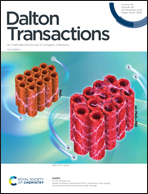A single-phase full-visible-spectrum phosphor for white light-emitting diodes with ultra-high color rendering†
Abstract
Excellent luminous performance and high color rendering are the keys to white light-emitting diode (WLED) illumination. This work reports a single-phase full-visible-spectrum Y2Mg2Al2Si2O12(YMAS):Eu2+,Mn2+ phosphor for WLEDs with ultra-high color rendering. The luminescence of a single Mn2+ doped YMAS phosphor is very weak due to the spin-forbidden transition of Mn2+, while it can be dramatically enhanced in the YMAS:Eu2+,Mn2+ system through efficient energy transfer from the sensitizer Eu2+. Meanwhile, the luminescent color of this phosphor can be tuned from cyan to cold white, to warm white, and finally close to the yellow region by controlling the activator concentration and energy transfer process. Its good thermal and chromaticity stability meet the requirements of application in WLEDs. Its stable photochromic performance at different excitation wavelengths (365–395 nm) indicates that it can be used in different ultraviolet chips. The YMAS:0.03Eu2+,0.30Mn2+ phosphor-converted WLED achieves an ultra-high color rendering index (Ra = 93.3), near-standard chromaticity coordinates (CIE = (0.3343, 0.3388)) and a suitable correlated color temperature (CCT = 5417 K).



 Please wait while we load your content...
Please wait while we load your content...